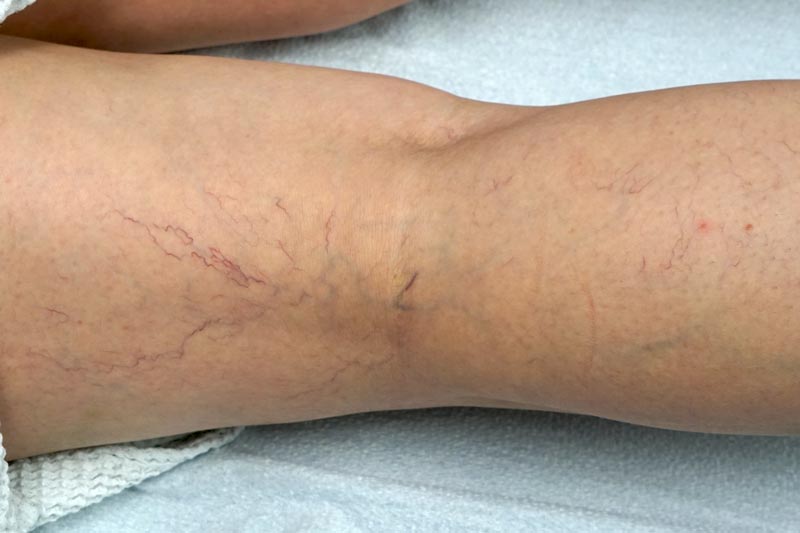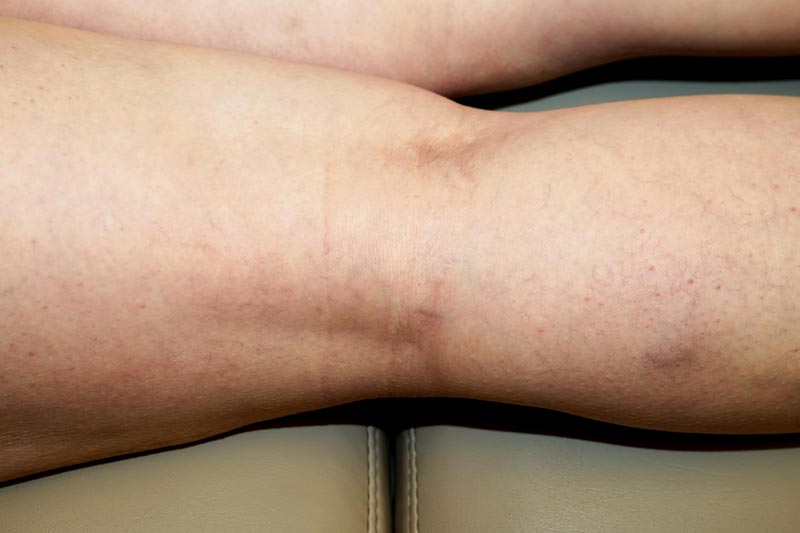Improve the look of your skin by eliminating unsightly veins! If you have unsightly leg veins, we can minimize the appearance with laser vein therapy and Sclerotherapy. Each individual is different and we will customize a plan that will give you the best results in the shortest amount of time. You don’t have to live with leg veins; we can improve the appearance with little or no downtime!
Millions of women are bothered by unsightly ‘spider veins’-those small yet noticeable clusters of red, blue, or purple veins that most commonly appear on the thighs, calves, and knees. In fact, it’s estimated that at least half of the adult female population is plagued with this common cosmetic problem.
Now with a pulse of the laser light, unsightly spider veins can diminish and disappear before your eyes.



Actual patient results.
Leg veins are a common problem occurring mostly in women. Common causes can be heredity, hormones, prolonged standing, obesity, age and pregnancy. Pregnancy is a common cause because of the increased blood volume and hormone levels as well as pressure of the uterus on the deep leg veins as they drain into the pelvis.
Spider veins-known in the medical world as telangiectasia’s or sunburst varicosities- are small, thin veins that lie close to the skins surface. Although these super-fine veins are connected to larger ones, they are not an essential part of the venous system.
Spider veins usually take on one of the three basic patterns. They may appear in a true spider shape with a group of veins radiating outward from a dark central point; they may be arborizing and will resemble tiny branch-like shapes; or they may be simple linear and appear as thin separate lines. Linear spider veins are commonly seen on the inner knee, whereas the arborizing pattern often appears on the outer thigh in a sunburst or cartwheel distribution.
Varicose veins differ from spider veins in a number of ways. Varicose veins are larger, darker in color and tend to bulge. Varicose veins are also more likely to cause pain and be related to more serious vein problems. Often, surgical treatment is required for this condition.
There are a couple of different options for leg veins depending upon their type and severity. Some varicose veins may be best treated with surgery. Spider veins or telangiectasia and reticular veins can be treated with lasers or Sclerotherapy. The decision on whether to use lasers, Sclerotherapy or a combination would be determined in a consultation at Lasting Skin Solutions®
Sclerotherapy is one vein treatment option for the elimination of spider veins and varicose veins. During the Sclerotherapy procedure, a sclerosing solution is injected into the vein through a micro-needle. The sclerosing solution causes the vein to blanch (turn white), then gradually to disappear. A typical treatment may last for 15 to 20 minutes and consist of multiple injections. Injection Sclerotherapy may eliminate the need for an invasive surgical procedure.
Complete correction of the treated area is not expected on the first treatment. In most cases, about 50-70% of the treated vessels will be gone for good.
Laser works on the veins by targeting the hemoglobin in the blood vessels, causing the blood to coagulate thus causing the vein to collapse and disappear from sight.
Patients are generally encouraged to resume normal activities immediately. We do ask that you refrain from vigorous activities for the first 24 hours. Walking is encouraged because it increases blood flow through the other veins. Although your final results may not be apparent for several months, most patients experience a 60% to 80% improvement.
Treatments can take anywhere from 15-60 minutes depending upon the severity of the veins.
The area treated can react in a couple of different ways. You may experience some initial swelling, which will subside in a few hours up to a couple of days. If you are treating leg veins, you will most likely bruise in the area treated and that can last for a couple of weeks. The vein can get darker initially and then gradually fade away.
Multiple treatments are usually recommended in the treatment of veins. On average it takes about three treatments to get the desired results. Treatment of veins is literally a battle, your first treatment weakens the veins, the second treatment weakens it a little more and by the third it usually gives up the battle and collapses.
Women of any age may be good candidates for laser vein therapy, but most fall into the 30 to 60-age range. In some women, spider veins may become noticeable very early on in the teen years. For others, the veins may not become obvious until they reach their 40s. If you are pregnant you may be advised to postpone laser vein therapy. In most cases, spider veins that surface during pregnancy will disappear on their own within three months after the baby is born.
Spider veins in men aren’t nearly as common as they are in women. Men who do have spider veins often don’t consider them to be a cosmetic problem because the veins are usually concealed by hair growth on the legs. However, laser vein therapy is just as effective for men who seek treatment.
Laser vein therapy can enhance your appearance and your self-confidence, but it’s unrealistic to believe that every affected vein will disappear completely as a result of treatment. After each session, the veins will appear lighter. Two or more sessions are usually required to achieve optimal results.
You should also be aware that the procedure treats only those veins that are currently visible; it does nothing to permanently alter the venous system or prevent new veins from surfacing in the future. Before you decide to have laser vein therapy, think carefully about your expectations and discuss them with your clinician.
Most patients are extremely pleased with the results of laser vein therapy and complications are unusual. However, complications may include ulceration of the skin that may heal with scar formation, pigmentation or discoloration-most will disappear in six to 12 months, and formation of new spider veins or sunburst blemishes.
The Diode Laser provides focused treatment of enlarged facial veins which cause the redness associated with Rosacea.
Learn more
Intense Pulsed Light (IPL) specifically targets the pigment or melanin in the skin to effectively remove the targeted sun damage or pigmentation issues.
Learn more
The laser mole removal technique is the preferred method which involves using a laser to target the cells within the mole to remove it.
Learn more
Superficial Laser and Light-based treatments can be used to remove the bacteria that cause acne outbreaks.
Learn more
Botox can be used to temporarily block the chemical signals from the nerves that stimulate the sweat glands.
Learn more
The Diode Laser provides focused treatment of enlarged facial veins which cause the redness associated with Rosacea.
Learn more
Intense Pulsed Light (IPL) specifically targets the pigment or melanin in the skin to effectively remove the targeted sun damage or pigmentation issues.
Learn more
The laser mole removal technique is the preferred method which involves using a laser to target the cells within the mole to remove it.
Learn more
Superficial Laser and Light-based treatments can be used to remove the bacteria that cause acne outbreaks.
Learn more
Botox can be used to temporarily block the chemical signals from the nerves that stimulate the sweat glands.
Learn more
OUR LOCATION
CLINIC HOURS
Monday: CLOSED
Tuesday: 10:30 AM – 5:30PM
Wednesday: 10:30AM – 5:30PM
Thursday: 9AM – 4PM
Friday: 9AM – 4PM
Saturday & Sunday: CLOSED
Questions?
Reach out to our team members or schedule a consultation.